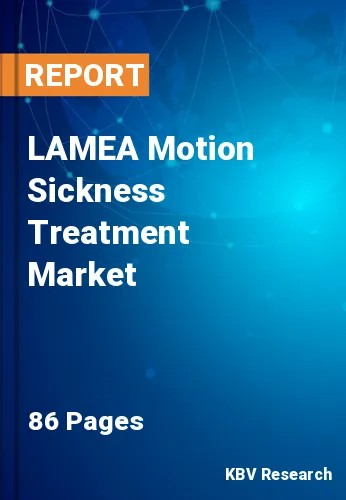The Latin America, Middle East and Africa Motion Sickness Treatment Market would witness market growth of 5.1% CAGR during the forecast period (2023-2029).
The motion sickness treatment market is expected to be driven by the increasing adoption of prescription drugs for motion sickness in developed economies in the coming years. Thus, based on the aforementioned factors, the market is anticipated to grow during the forecast period.
Techniques that include traditional neurophysiology, pathway mapping, and magnetic resonance imaging (MRI) have contributed to a deeper understanding of the neurological mechanisms related to motion sickness. Nauseogenic IT has become a widely used approach for studying neurophysiology and brain regions associated with this condition. The utilization of nauseogenic vehicles enables the assessment of an individual's postural stability and the identification of neural or sensory-motor mechanisms that contribute to achieving favorable bodily stability.
The critical knowledge of Nauseogenic information technology can aid in the development and improvement of motion sickness drugs, ultimately contributing to the growth of the industry. The growth of the industry is expected to be positively impacted by the advancement in information technology related to nausea and the easy accessibility of over-the-counter drugs. However, adverse reactions linked to medication for motion sickness may impede the progress of the sector throughout the projected timeframe.
Dubai has become a prominent and popular travel destination within a period of 25 years. The city has demonstrated superior performance compared to other tourism businesses in the past. Dubai is renowned for its naturally formed architectural wonders that attract a large number of tourists, including the Burj Khalifa and Burj Al Arab, which are widely regarded as the most popular tourist attractions.
The increase in vacationers to the region has led to a rise in the tourism sector, attracting more tourists to the region, which are likely to suffer from motion sickness and utilize various treatments medication like anticholinergics and antihistamines, thus surging the market growth in the region.
The Brazil market dominated the LAMEA Motion Sickness Treatment Market by Country in 2022; thereby, achieving a market value of $8.3 Million by 2029. The Argentina market is experiencing a CAGR of 5.7% during (2023 - 2029). Additionally, The UAE market would exhibit a CAGR of 4.8% during (2023 - 2029).
Based on Drug Class, the market is segmented into Antihistamines, Anticholinergics and Others. Based on Route of Administration, the market is segmented into Oral and Others. Based on Distribution Channel, the market is segmented into Drug Store & Retail Pharmacies, Hospital Pharmacies and Online Pharmacies. Based on countries, the market is segmented into Brazil, Argentina, UAE, Saudi Arabia, South Africa, Nigeria, and Rest of LAMEA.
Free Valuable Insights: The Worldwide Motion Sickness Treatment Market is Projected to reach USD 481 Million by 2029, at a CAGR of 3.2%
The market research report covers the analysis of key stake holders of the market. Key companies profiled in the report include Viatris, Inc., Teva Pharmaceutical Industries Ltd., Amneal Pharmaceuticals, Inc., Baxter International, Inc., Novartis AG, Abbott Laboratories, Sun Pharmaceutical Industries Ltd., Zydus Lifesciences Ltd., Prestige Consumer Healthcare, Inc., WellSpring Pharmaceutical Corporation (Avista Capital Partners).
By Drug Class
By Route of Administration
By Distribution Channel
By Country
Our team of dedicated experts can provide you with attractive expansion opportunities for your business.

